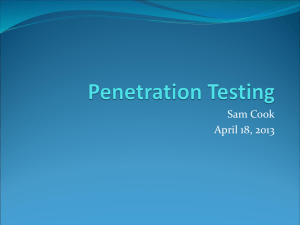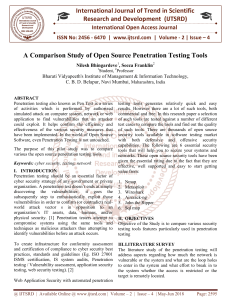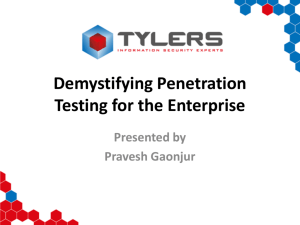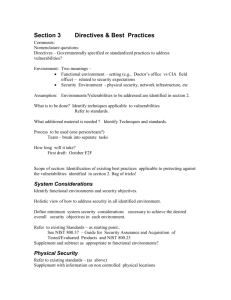The Art of Penetration Testing
advertisement
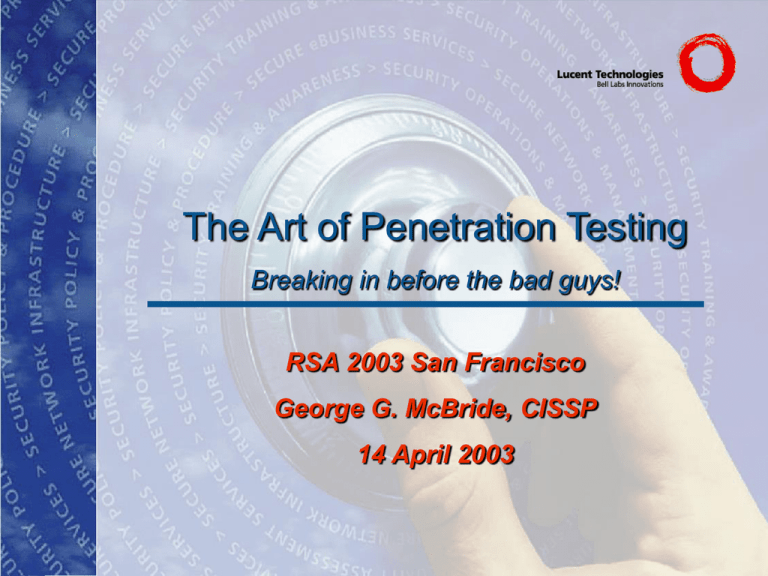
The Art of Penetration Testing Breaking in before the bad guys! RSA 2003 San Francisco George G. McBride, CISSP 14 April 2003 1 Goals (Why am I here at 8 AM?) Define the penetration test, also called a pen test and “ethical hacking” Talk about legal issues Set some boundaries…goals Talk about when things go bad Walk through the major pen test steps Introduction to some tools 2 What is it? Penetration Test: Identifying vulnerabilities of a particular system, application, network, or process Exploiting those vulnerabilities to demonstrate that the security mechanisms can and will fail The good guys usually get some small piece of proof and exit as quietly as they came 3 Legal Issues Before You Start First, can you do what you want to do where you want to do it? Is a war-dial legal against your own systems when going through a central office? Make sure you are protected with a “Letter of Authority”. Protect yourself with a “Get out of jail” type letter. More to come. Encrypt your data. You don’t want to be liable if your data is compromised. 4 More Lawyer Speak Watch, and throttle if necessary, your generated network traffic…Think stealth and covert. Think through your actions before doing them. Run these tools at your own risk. You are responsible for what you do. Test them on a stand-alone network with a network sniffer and review the source code Obtain tools from the source Verify checksums from multiple sources when applicable Log all of your actions 5 Why Do You Want a Pen-Test? If you want to measure overall risk, think about an assessment which will give you a better review of the vulnerabilities and current security mechanisms. A penetration test is used to show where security fails. Can test intrusion detection and incident response. Can be used to justify the need for an upgrade, bigger budget, or to validate risk assessments. 6 What are your boundaries? Be as aggressive as you can and work to be creative. Now is when you can use the “thinking out of the box” classes that we’ve taken. Don’t get tunnel vision Are you going to do physical penetrations? Actually trying to break-in, vs Wandering where you shouldn’t What about “social engineering”? 7 More Boundaries to Consider Application Service Providers (how can you use them?) Externally hosted resources Non-company equipment All need to be addressed with each customer and agree upon. 8 Coordinating Activities Identify activities, persons, processes, and events that could affect the penetration test: Network quiet time Major upgrades Layoffs Strikes Administrator’s day off Late at night when the NID monitoring staff is sleeping Your advantage? 9 What’s your perspective? Before proceeding, decide what perspective your team will take during the exercise. What will the initial level of access and the amount of information be? Outsider with no previous knowledge Outsider with insider knowledge (with an inside partner or former insider) Low level insider (end-user) High level insider (system or network administrator) 10 The Authorization Letter A signed letter from the “appropriate person”. This could be an officer, the CIO, owner, etc. Includes: Who will perform the test When the test will be performed Why the test is being performed What types of activities will take place. Includes targeted systems or locations Customer contacts for verification May include reasons to prematurely conclude the test Request cooperation to minimize notification of your activities Is legal review of the letter important? May address liability issues 11 Premature Termination Why would you end your test before the allotted time-frame? Busted! The customer has detected your activities and sounded the alarm You’ve caused a negative impact such as a network or system outage You are not the person to successfully gain access You uncover such a significant vulnerability that you need to alert the system or network administrators You were slightly off on your IP addresses You’ve achieved your goal 12 The Pen-Test Paradox Remember, in general, success from your perspective does not equal success from your customer’s perspective. Somebody generally goes home unhappy. Watch morale issues on your team. 13 Turning a black-box pen test into a white-box pen test. Depending on your target, can you obtain a “clone” of the target? It is often a lot easier to experiment, play, and sometimes destroy a controlled system For example, based on your finger printing results, you’ll have a pretty good idea of the current configuration. Configure another machine as a clone Borrow or buy a clone system 14 The Pen Test Team The best team “enjoys” their particular area of expertise…Its more than just a job to them. Because of the level of communication and coordination that is required, smaller teams work better. Small is relative compared to the target, but 2 – 3 core people should suffice Pull in experts as needed, i.e, BGP router expert, LDAP pro, etc. It’s best to get the testers into a separate conference room, spare office, etc to collaborate with minimal distractions I’ll take a person with stronger ethics over a person with strong technical skills. 15 Penetration Testing Methodology Let’s walk through the following major steps of a pen-test: Recon / Foot printing Scanning Enumeration Exploiting / Penetrating Privilege escalation as required Data collection aka “limited pillaging” Cleaning-Up Prepare & Deliver Report / Presentation 16 Developing a methodology Work on establishing your own methodology using pre-existing methodologies as guides: SANS Institute for Security and Open Source Methodologies (ISECOM) Common Criteria Complete a rough draft of your methodology before starting and finalize after your first penetration test. Your methodology should be a living document. 17 Reconnaissance & Foot printing Look, but don’t touch. This is a lot of web-based searching and reviewing. Fire-Up the Browser and review: Monster/HotJobs/Dice, etc. All Whois (www.allwhois.com) ARIN Whois (www.arin.net) Or APNIC, Ripe Whois, LAPNIC Sam Spade Microsoft Windows application Sam Spade.org US SEC’s Edgar database 18 The Web: A little bit deeper Here’s a Google search on “enable secret”. The poster has masked the first two octets of his IP address. But has left his company name in his email! 19 More web resources And again, another Google Search 20 Netcraft also has good info Starting out lightly Check Netcraft for information 21 Trace route also gives info Visual Traceroute gives NO useful info over command-line traceroute (and shouldn’t work internally), but looks really cool. 22 Last external recon web-site Sam Spade: Web site provides some level or anonymity. Web-based version works just as well. 23 Internal resources are valuable! Does your target company have an internal search engine? Searches on things like “SAP”+”security” or “config” or “setup” can divulge great information. What about inventory or asset management systems that provide automated data collection? May be able to extract inventory and configuration information. 24 Almost ready. You must have a log-book of every activity that everybody does Electronic or manual, just include the basics of who, what, when, and how. Linux “script <filename>” command is a great tool to save your logs for each terminal session. Control-D exits and I use a convenient (but long) filename such as exchpt.gm.2003mar04. Plan your efforts and communicate continuously with team members. 25 Murphy’s Law Everything that goes wrong on the target host, network, or on the Internet from two weeks before you plug in to two weeks after you submit the report will be your fault. Document everything! Can you script operations to increase efficiency and reduce errors? 26 Breaking Down the Door As you enter through the loading dock, you don’t want to encounter the summer hire black-belt student who’s watched COPS too many times. This is really why it is called the “get out of jail” letter. Make sure it is in your pocket. Plan and practice what you will do in the facility. Know what your “story” will be if questioned so the whole team gives the same answer. Most times the guards will hold the door open for you. 27 Why is physical access important? Install sniffer on server or administrators network Have console access (local exploits or maybe there is no PW protected screen saver). Grab documents, configurations, any other documentation Grab back-up tapes or other media for review Make your own back-up 28 Social Engineering The gentle art of deception, misrepresentation, and persuasion to get somebody to do something. Sometimes it’s just asking the right question to the right person and sometimes, it’s setting an elaborate plan into action. Check out Kevin Mitnick’s book “Art of Deception” for more information on Social Engineering and Ira Winkler’s book “Corporate Espionage” if you can find it. 29 Reviewing your traffic Snort output in sniffing mode. Snort is great as it can be used to trigger alarms as required. Let’s you know when the target starts to fight back! 30 Simple Reviewing / Logging Using “tcpdump”, you can review the data that you send and receive. Not as easy to set alerts. 31 Firewalls are not your friend Watch firewalls between you and the target Unless it is part of your test, relocate. For example, to attack machines on the perimeter, get a raw Internet account through an ISP. Make sure you disable the personal firewalls on your systems Note: you may also have to disable anti-virus software depending on what tools you are using. 32 Making some noise. Key Point: Balance your noisy scans with your desired level of stealth Firewall type could provide information into what types of scans are best suited Firewalk is a great tool to use specifically crafted packets to locate targets behind a firewall. Nmap can be used to perform any number of types of port scans. Any tool can set off IDS or alert an administrator. Use VERY Carefully Use only the tools you NEED 33 Scanning SNMP can give information Linux has “snmpwalk” built in Can also use tools to walk the MIB and get configuration, routing, or other information. Other tools such as Nmap and Nessus as well as many other tools are great choices. Other specific tools such as SQLPing, WebProxy, etc will help. 34 Nmap for Linux Sending a series of specially crafted packets to a target to identify open or listening UDP/TCP ports Nmap V3: More options to send a SYN packet that you can imagine. 35 Foundstone’s Windows App: SuperScan: Microsoft Windows GUI 36 Nessus, The Champ Open Source Significant, timely, and relevant vulnerability checks available It’s easy to write your own checks that are not available Engine requires a Linux server, client can be Linux or Microsoft Windows based Intelligent, assumes little, but uses what it learns as it scans Vendor neutral, so nothing is “sugar coated” and recommended fixes don’t point you towards their products 37 Conclusion of a Nessus Session Review of results through Nessus GUI Output Options: •Text •HTML •PDF •CSV •SQL 38 Some pen testing tools This list is not meant to be all inclusive, but to give some examples of tools that you’ll need. Firewalk is a great tool to determine hosts behind a firewall. NetCat (www.atstake.com) offers NT and Linux versions. Small and simple, yet incredibly powerful. Get NetCat on a Microsoft Windows box and type: nc –L –p 53 –e cmd.exe Run NetCat in Listen mode, on port 53, and execute cmd.exe. 39 The tools – Netcat Session Simple Netcat connection between a Linux and Microsoft Windows machine. Add Foundstone’s FPipe and redirect traffic…In one port, out a different 40 “dsniff” – The “snarf” tool dsniff is a great tool which acts as a man in the middle (or as Dug Song says, “monkey in the middle”) to sniff network traffic and easily grab URLs, WWW, POP3, Oracle passwords and a lot more including SSH and HTTPS sessions. dsniff uses ARP spoofing to impersonate the gateway Mitigates the protection of a switch 41 Ettercap Similar to dsniff, Ettercap seems to be a little bit more versatile and up to date. Great tool to reconstruct sessions. 42 Windows Password Utilities PWDump2: Dumps the one-way hashes from the SAM Database which can be imported to L0phtCrack or John The Ripper 43 DumpSec Another great tool for reviewing permissions, group memberships and lots of registry info. Pwdump3: Does a great job at grabbing the password hashes remotely. 44 A great brute force tool Hydra is a great parallel login brute forcer Brutus is another great tool Samba, FTP, POP3, IMAP, Telnet, HTTP, Auth, LDAP NNTP, VNC, ICQ, Socks5, PCNFS, Cisco and more. 45 WWW Scanners Whisker V2.1(www.wiretrip.net) Nikto V1.23 Uses Whisker’s Libwhisker Has their own line of apparel! WebSleuth has a free version along with their paid version Check out Open Web Application Security Project (www.owasp.org). Tools like WebGoat, WebScarab, and VulnXML are great. Nikto Command Line: ./nikto.pl –h www.target.com –o nikto.out 46 Sample Nikto Output Review of results. Some good information which needs to be reviewed. 47 Getting in through the Web Best way is still going to include: Mirroring of web-site Search for comments, passwords, hidden fields Manual Manipulation of web-site including cookies, input, etc Recommend use of Achilles, the web-proxy, available at: www.packetstormsecurity.org This tool allows you to intercept and modify session data between server and client An alternate web-proxy which allows you to intercept and view all traffic between server and client is Proxomitron @Stake’s Web Proxy ($$$) is quite nice also 48 Finding Vulnerabilities by System You may not find all vulnerabilities through system scanners Check out web-sites such as: www.oracle.com/security www.microsoft.com/security www.redhat.com/solutions/security/news/ www.ntbugtraq.com www.securityfocus.com www.cert.org www.google.com www.astalavista.com (Not Altavista!) www.mitre.org 49 Exploitation So where do you find the vulnerabilities? Let’s say Nessus identifies an RPC Statd Format String Vulnerability: If you go into Google and search for “RPC Statd exploit code”, you are directed to: http://downloads.securityfocus.com/ vulnerabilities/exploits/statd-toy.c 50 Is it that easy? Just about. You’ve now got the code that you have to understand and compile. 51 Exploit Sites….Find your own! www.packetstormsecurity.org neworder.box.sk/ www.securiteam.com/exploits www.hoobie.net/security/exploits/ www.insecure.org/sploits.html www.astalavista.com/tools IRC Channels Usenet Groups 52 Privilege Escalation? Huh? Privilege Escalation is used when you are able to get some level of access to a system, but it is not sufficient for what you need to do. Essentially turning a system/process/user level account into a privileged account such as administrator or root. An old favorite was “HK”. Working only on Microsoft Windows NT up to SP6, this would allow you to use: “HK NC –l –p 23 –t –e cmd.exe” There are still a lot of tools that do similar things. 53 Not everything needs code Other than the physical and social engineering work, there are also: Configuration flaws (ie, “backupuser” is part of the administrators group) and the account password is in the .ini file The web-server does not use encrypted cookies and you can identify the pattern which allows you to get the info you need The system administrators password is “admin” 54 I can’t write code! Design Flaws Web Server not appropriately protected because there is no firewall in front of it. Logical Flaws The client server application doesn’t check the password when the administrator logs on Implementation Flaws Firewall rules not set-up properly. Wireless Modem Scans 55 Cleaning up the mess Return the system to the same state it was. Remove all tools If you don’t need to, I wouldn’t mess with the logs. To fix or not fix the vulnerability you exploited. That is the question! 56 Writing It Up Once you’ve completed your penetration test, it’s time to write it up. Using the methodology that you’ve previously developed, I’d recommend a report similar to a Risk Assessment report: Vulnerability Name Business Impact (If desired) Risk Level: 1 to 5, High, Med, Low, etc Description: In detail what the problem is and how you found it. Corrective Action: What must be done. Group Responsible for corrective action. 57 Special Delivery Get the report out no later than few days after the conclusion of the effort. Before corrective actions are implemented, ensure that the distribution of the report is extremely limited. Work with the customer to deliver a “nonabrasive/abusive” report. No boasting, no finger-pointing, try to sanitize the report as much as possible to remove the names of the guilty. 58 Questions? Feel free to contact me if you have a question or comment; or you’ve found a great new tool. Check out my web-site, www.digdata.com for additional resources and updates. Lucent Technologies Bell Labs Innovations George McBride Network Security Senior Manager Lucent Security Lucent Technologies Inc. Room 2N-611J 101 Crawfords Corner Road Holmdel, NJ 07733 Phone: +1.732.949.3408 E-mail: gmcbride@lucent.com 59

